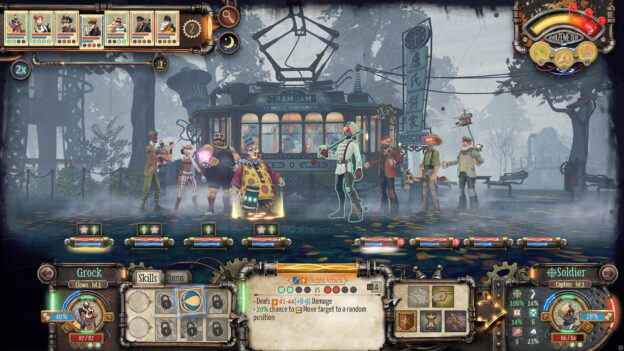I’ve played a lot of different RPGs during my forty-plus years of gaming. I’m a massive fan of the genre and thought I’d seen it all. That was until I played Circus Electrique, a game that has an intriguing story, steam-punk artwork, and incredible voice acting. And did I mention that circus performers make up your team? While it doesn’t always land in all aspects, it’s an interesting concept, and the story carries the game.

The narrative takes place in London during the late 1880s and follows a newspaper reporter named Amelia. She’s investigating something known as The Maddening, which is causing the people of London to attack one another. Amelia’s backstory is fascinating. Her mother was a circus performer who died in a horrible accident ten years before the current events in the game, causing the circus to close. However, her uncle, the ringmaster, recently brought the show back. Amelia doesn’t trust her uncle and suspects he’s somehow involved in the recent events. He insists she takes a group of performers with her as she digs into the story. The entire game is voice-acted, and the acting is well done.
Another strength is the artwork. Since the game takes place in Victorian London, the mix of the background scenes and the steampunk vibe is vibrant and visually appealing. In addition, the circus performers on your team are both charming and creepy looking, especially the clowns. Indeed, they look more menacing than enemies.

A lot is going on in this game. While there is a tutorial, a welcomed codex is available, which you can access when you have questions. A unique aspect during combat is devotion, a separate meter determining the character’s success. The higher the devotion, the more damage you’ll do. Different skills also affect this stat. For instance, my clown could cheer up my party, increasing the team’s overall devotion. Conversely, my strongman’s intimidation ability lowered the opponent’s stats.
Another feature is the Amazemeter, which only unlocks after you beat the first boss. Using a character’s skills fills up the gauge and allows you to unleash some powerful attacks or heal. You can upgrade the Amazemeter and experiment with it by putting abilities into different slots.

The gameplay is a mix of both turn-based battles and circus management. The management aspect has you drafting and placing performers into the show. Every gig has different slots with the preferred performance types. Each team member has a card indicating their best placement in the production and a chemistry icon that shows with whom they work best. The higher the chemistry, the better the outcome, meeting or exceeding the crowd’s expectations.

There are a few things that prevent the game from sticking the landing. The circus management is neat but interrupts the game’s overall flow. After each battle, you’ll need to set up another show. Because of this, I was often pulled out of the story when I just wanted to progress.
Another downside is the print and icons for each character, which are small and hard to see in handheld mode. Playing on a large TV works but is challenging to play handheld. However, these criticisms didn’t take away from my overall enjoyment of the game.
Review: Circus Electrique (Nintendo Switch)
Good
Circus Electrique is unlike any other RPG. Genre fans who like deep stat management will find a lot to like here. The mix of circus management and combat makes for a unique experience, although the management aspect does disrupt the flow. The game’s strength is in its storytelling and how well the voice acting and art compliment the narrative. The preferred way to play this game is on the TV, as in handheld mode, it’s difficult to read the text or see the different icons for the characters.


